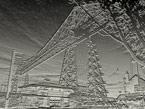
TEES ESTUARY TO YARM

"Until dredging operations created a main channel for sea-going vessels, the mouth of the river consisted of extensive mudflats and shifting sands. By 1900 more than half of Teesmouth's 2,400 hectares of inter-tidal mudflats had been reclaimed by industrial use and during the nineteen-sixties and nineteen-seventies much of the remaining land was also developed."
The River Tees. A North Country River. R Woodhouse. 1991
The Tees Estuary is wide and is bordered by sand dunes with a variety of plants. Various birds, insects and animals, including seals, also live on and around the estuary.
The main channel for sea-going vessels is reached through the breakwaters on either side of the river mouth, called the North and South Gare. The river at first flows south from the North Sea and Greatham creek flows into the estuary on its west side. There is public access to the Gares and Teesmouth National Nature reserve is located at North Gare sands. Near the South Gare is a lifeboat station and a pilots station as part of a small harbour called Paddy's Hole. A coastguard station and radio mast are also present, and a lighthouse too. North Gare is half a mile long and was built in the late 19th century (1882 to 1891) while South Gare is over two and a half miles in length and was constructed between 1863 and 1888.
Teesport and Hartlepool is the third biggest port in Britain and lies on the south bank of the Tees. The banks of the estuary are littered with industry, steelworks, chemical plants, a nuclear power station, an oil refinery and the Redcar Ore Terminal. The town of Middlesbrough is situated upstream on the river's south bank, while the town of Hartlepool is a little to the north.
The Tees then passes Stockton with its road and rail bridges now joined by the Teesquay Millenium Bridge. The Yorkshire town of Yarm with two fine old bridges marks the end of the industrial stretch of the Tees and the beginning of the rural part of the river.
The Teesdale Way, a long distance walk along the Tees starts from near Middlesbrough.
- Transporter Bridge - 1911
- Newport Vertical Lift Bridge - 1934
- A19 Tees Viaduct - 1975
- Tees Barrage - 1995
- Princess of Wales Bridge - 1992
- Teesquay Millenium Bridge Stockton - 2000
- Victoria Bridge Stockton - 1887
- Stockton Railway Bridges - 1844 and 1882?
- A66 Surtees Bridge -1982
- Jubilee Bridge -2002
- Preston Pipe Bridge - 1959
- Yarm Road Bridge - 1400
- Yarm Railway Viaduct - 1851

